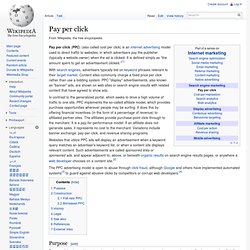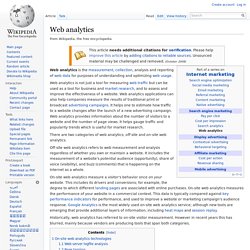

SEM - search Engine Marketing. PSM - Paid Search Marketing. Pay per click. Pay per click (PPC) (also called cost per click) is an internet advertising model used to direct traffic to websites, in which advertisers pay the publisher (typically a website owner) when the ad is clicked.

It is defined simply as “the amount spent to get an advertisement clicked.”[1] In contrast to the generalized portal, which seeks to drive a high volume of traffic to one site, PPC implements the so-called affiliate model, which provides purchase opportunities wherever people may be surfing. It does this by offering financial incentives (in the form of a percentage of revenue) to affiliated partner sites. The affiliates provide purchase-point click-through to the merchant. It is a pay-for-performance model: If an affiliate does not generate sales, it represents no cost to the merchant. Websites that utilize PPC ads will display an advertisement when a keyword query matches an advertiser's keyword list, or when a content site displays relevant content.
Purpose[edit] History[edit] Link Building. For search engines that crawl the vast metropolis of the web, links are the streets between pages. Using sophisticated link analysis, the engines can discover how pages are related to each other and in what ways. Since the late 1990s search engines have treated links as votes for popularity and importance in the ongoing democratic opinion poll of the web. The engines themselves have refined the use of link data to a fine art, and use complex algorithms to perform nuanced evaluations of sites and pages based on this information.
Links aren't everything in SEO, but search professionals attribute a large portion of the engines' algorithms to link-related factors (see Search Engine Ranking Factors). Through links, engines can not only analyze the popularity websites and pages based on the number and popularity of pages linking to them, but also metrics like trust, spam, and authority.
Link Signals Used by search engines How do search engines assign value to links? Global Popularity Anchor Text. SEO - Search Engine Optimization. WE / AW - Web analytics - Audience web. Web analytics is not just a tool for measuring web traffic but can be used as a tool for business and market research, and to assess and improve the effectiveness of a website.

Web analytics applications can also help companies measure the results of traditional print or broadcast advertising campaigns. It helps one to estimate how traffic to a website changes after the launch of a new advertising campaign. Web analytics provides information about the number of visitors to a website and the number of page views. It helps gauge traffic and popularity trends which is useful for market research. There are two categories of web analytics; off-site and on-site web analytics. Off-site web analytics refers to web measurement and analysis regardless of whether you own or maintain a website.
On-site web analytics measure a visitor's behavior once on your website. Historically, web analytics has referred to on-site visitor measurement. On-site web analytics technologies[edit] Page tagging[edit] Website monitoring. Website monitoring is the process of testing and verifying that end-users can interact with a website or web application as expected.

Website monitoring is often used by businesses to ensure website uptime, performance, and functionality is as expected. Website monitoring companies provide organizations the ability to consistently monitor a website, or server function, and observe how it responds. The monitoring is often conducted from several locations around the world to a specific website, or server, in order to detect issues related to general Internet latency, network hop issues, and to pinpoint errors.[1] Monitoring companies generally report on these tests in a variety of reports, charts and graphs.
When an error is detected monitoring services send out alerts via email, SMS, phone, SNMP trap, pager that may include diagnostic information, such as a network trace route, code capture of a web page's HTML file, a screen shot of a webpage, and even a video of a website failing. SMM - Social Media Marketing.